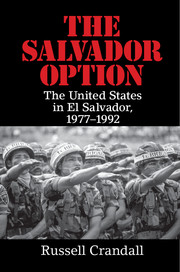Book contents
- Frontmatter
- Dedication
- Epigraph
- Contents
- List of Figures
- List of Organizations
- Acknowledgments
- 1 Introduction
- PART ONE EL SALVADOR IN THE COLD WAR
- PART TWO JIMMY CARTER
- 7 Revolution and Counterinsurgency in Guatemala
- 8 Mass Organizations
- 9 Carter Arrives
- 10 Carter and the Sandinista Revolution in Nicaragua, 1979
- 11 An October Coup
- 12 Carter Engages Salvador
- 13 Archbishop Romero
- 14 Land
- 15 The American Churchwomen
- 16 Arming the Rebels
- 17 Guerrilla Final Offensive, January 1981
- 18 Death Squads
- PART THREE RONALD REAGAN
- PART FOUR GEORGE H. W. BUSH
- PART FIVE POSTWAR
- Notes
- Bibliography
- Index
8 - Mass Organizations
from PART TWO - JIMMY CARTER
Published online by Cambridge University Press: 05 June 2016
- Frontmatter
- Dedication
- Epigraph
- Contents
- List of Figures
- List of Organizations
- Acknowledgments
- 1 Introduction
- PART ONE EL SALVADOR IN THE COLD WAR
- PART TWO JIMMY CARTER
- 7 Revolution and Counterinsurgency in Guatemala
- 8 Mass Organizations
- 9 Carter Arrives
- 10 Carter and the Sandinista Revolution in Nicaragua, 1979
- 11 An October Coup
- 12 Carter Engages Salvador
- 13 Archbishop Romero
- 14 Land
- 15 The American Churchwomen
- 16 Arming the Rebels
- 17 Guerrilla Final Offensive, January 1981
- 18 Death Squads
- PART THREE RONALD REAGAN
- PART FOUR GEORGE H. W. BUSH
- PART FIVE POSTWAR
- Notes
- Bibliography
- Index
Summary
We're not talking about pragmatic Sandinistas. This is a Pol Pot Left.
– El Salvador News Gazette, April 27, 1980The largest of the three peasant-worker-student coalitions [BPR], has grown to 30,000 members in the past four years despite, or because of, frequent repression.
– Alan Riding, New York Times correspondent, 1979.“Guerrilla Universitaria”
Travel writer Paul Theroux was visiting El Salvador in the late 1970s to deliver a lecture at the National University in San Salvador on “little known books by famous American authors.” With the literary event concluded, it occurred to him that he had “nothing more to do in San Salvador.” He then had a question for his local hosts that no one seemed to have a good answer for: why was there a mural of Marx, Engels, and Lenin in the university during the rule of a right-wing dictatorship? Theroux had visited the National University at a time when it was actually open. In 1972, the military regime forcibly closed it using tanks and artillery and kept it shuttered until 1974. In 1980, the military/civilian junta once again moved troops onto the campus, leaving dozens dead and offices and classrooms destroyed. The government did not open the university for four years.
American novelist and literary journalist Joan Didion described the state of the campus after visiting in 1982:
A few classes were being held in storefronts around San Salvador, but no one other than an occasional reporter had been allowed to enter the campus since the day the troops came in. Those reporters allowed to look had described walls still splashed with the spray-painted slogans left by the students, floors littered with tangled computer tape and with copies of what the National Guardsmen in charge characterized as subversive pamphlets, for example, a reprint of an article on inherited enzyme deficiency from The New England Journal of Medicine.
Another foreign correspondent described the government's justification for closing the university: “It claimed, with some plausibility, that it was a recruiting and training ground for rebels. Some of us sneaked onto campus soon after the closure and found some classroom blackboards still covered with diagrams for bomb-making.” The paradoxes that Theroux and Didion experienced lay at the heart of El Salvador's emerging ideological and eventually armed insurrection.
- Type
- Chapter
- Information
- The Salvador OptionThe United States in El Salvador, 1977–1992, pp. 90 - 101Publisher: Cambridge University PressPrint publication year: 2016

